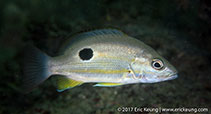| Family: |
Lutjanidae (Snappers), subfamily: Lutjaninae |
| Max. size: |
50 cm TL (male/unsexed) |
| Environment: |
reef-associated; brackish; marine; depth range 3 - 80 m |
| Distribution: |
Western Pacific: Indian Ocean distribution provisionally included as records of L. indicus; species needs to be reassessed, preferably utilising genetic analysis. |
| Diagnosis: |
Dorsal spines (total): 10-10; Dorsal soft rays (total): 14-14; Anal spines: 3-3; Anal soft rays: 8-8. This species is distinguished by the following characters: body moderately deep to somewhat slender, greatest body depth 2.6-2.8 in SL; preopercular notch and knob poorly developed; vomerine tooth patch triangular or diamond-shaped, with a medial posterior extension; tongue with a patch of granular teeth; gill rakers of first gill arch 6-7 + 7-11 = 13-18 (including rudiments); caudal fin truncate or slightly emarginate; scale rows on back rising obliquely above lateral line. Colour generally pink to whitish with a silvery sheen; a black spot, mainly above lateral line, below anterior rays of soft dorsal fin (adults from the Indian Ocean usually with 7-8 narrow golden brown stripes on sides); juveniles whitish with black stripes on sides and most Indo-Pacific fish with a pale-edged round black spot on upper back (Ref 9821, 90102).
Description: Dorsal profile of head steeply to moderately sloped; preorbital width about equal to, or slightly less than eye diameter (Ref. 9821). |
| Biology: |
Adults inhabit offshore coral reefs and also inshore rocky and coral reefs (Ref. 30573), at moderate depths, usually over 20 m, and is more common in about 50 m depth (Ref. 48635). Juveniles frequent mangrove estuaries and lower reaches of freshwater streams (Ref. 30573, 48635). They feed on benthic invertebrates and fish (Ref. 5213). Sold in Hong Kong live fish markets (Ref. 27253). A common market fish throughout its range; also a component of artisanal fisheries. Caught with handlines, traps, and bottom trawls and marketed mostly fresh (Ref. 9821). |
| IUCN Red List Status: |
Least Concern (LC); Date assessed: 05 March 2015 Ref. (130435)
|
| Threat to humans: |
harmless |
Source and more info: www.fishbase.org. For personal, classroom, and other internal use only. Not for publication.

